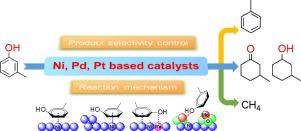Catalysis Today ( IF 5.3 ) Pub Date : 2021-01-12 , DOI: 10.1016/j.cattod.2020.12.033 Xiaoxia Wu , Qingfeng Ge , Xinli Zhu

|
Catalytic hydrodeoxygenation (HDO) of phenolics is a crucial step to convert lignin-biomass to chemicals and fuels. Catalysts based on group 10 metals (Ni, Pd and Pt) are widely used in HDO of phenolics. However, achieving a high yield toward the desirable product remains a challenge since a number of competing reactions take place at the same time, resulting in a complex product distribution. Herein, we review the recent advances in understanding the reaction mechanism on group 10 metal based catalysts and the novel strategies for selective deoxygenation of phenolics to aromatics on these catalysts under mild conditions (intermediate temperature and atmospheric pressure). Typically, HDO on Ni, Pd and Pt involves three main reaction pathways: a) hydrogenation to cyclohexanones/cyclohexanols; b) deoxygenation to aromatics, and c) C − C hydrogenolysis to CH4. Among the possible mechanisms proposed for deoxygenation to aromatics, the partial hydrogenation mechanism shows the lowest barrier for C − O cleavage, and is therefore most likely to happen. Strategies such as increasing affinity to the O atom of phenols on the surface of Ni, Pd and Pt based catalysts by either reducing the particle sizes, alloying with an oxophilic metal, modifying the metal catalyst with a reducible oxide, or combining with an acidic zeolite have been reviewed. These strategies have been shown to improve the selectivity of HDO to aromatics over the hydrogenation and C − C hydrogenolysis products and are expected to provide useful guidance for rational design of the selective HDO catalysts.
中文翻译:

10族金属基催化剂上酚类化合物的气相加氢脱氧:反应机理和产物
酚醛的催化加氢脱氧(HDO)是将木质素生物质转化为化学物质和燃料的关键步骤。基于10族金属(Ni,Pd和Pt)的催化剂被广泛用于酚醛树脂的HDO中。然而,由于同时发生许多竞争性反应,导致复杂的产品分布,因此实现所需产物的高产率仍然是一个挑战。本文中,我们回顾了了解第10组金属基催化剂的反应机理的最新进展以及在温和条件(中温和大气压)下将这些催化剂上的酚类选择性脱氧为芳烃的新策略。通常,在Ni,Pd和Pt上的HDO涉及三个主要反应途径:a)加氢成环己酮/环己醇;b)脱氧成芳烃,4。在提议的将芳烃脱氧的可能机理中,部分氢化机理显示出C-O裂解的最低障碍,因此最有可能发生。通过减小粒径,与亲氧性金属合金化,用可还原氧化物改性金属催化剂或与酸性沸石结合来提高Ni,Pd和Pt基催化剂表面上的酚类O原子的亲和力等策略已审查。这些策略已被证明可以提高HDO对芳烃在氢化和C-C氢解产物上的选择性,并有望为合理设计选择性HDO催化剂提供有用的指导。



























 京公网安备 11010802027423号
京公网安备 11010802027423号